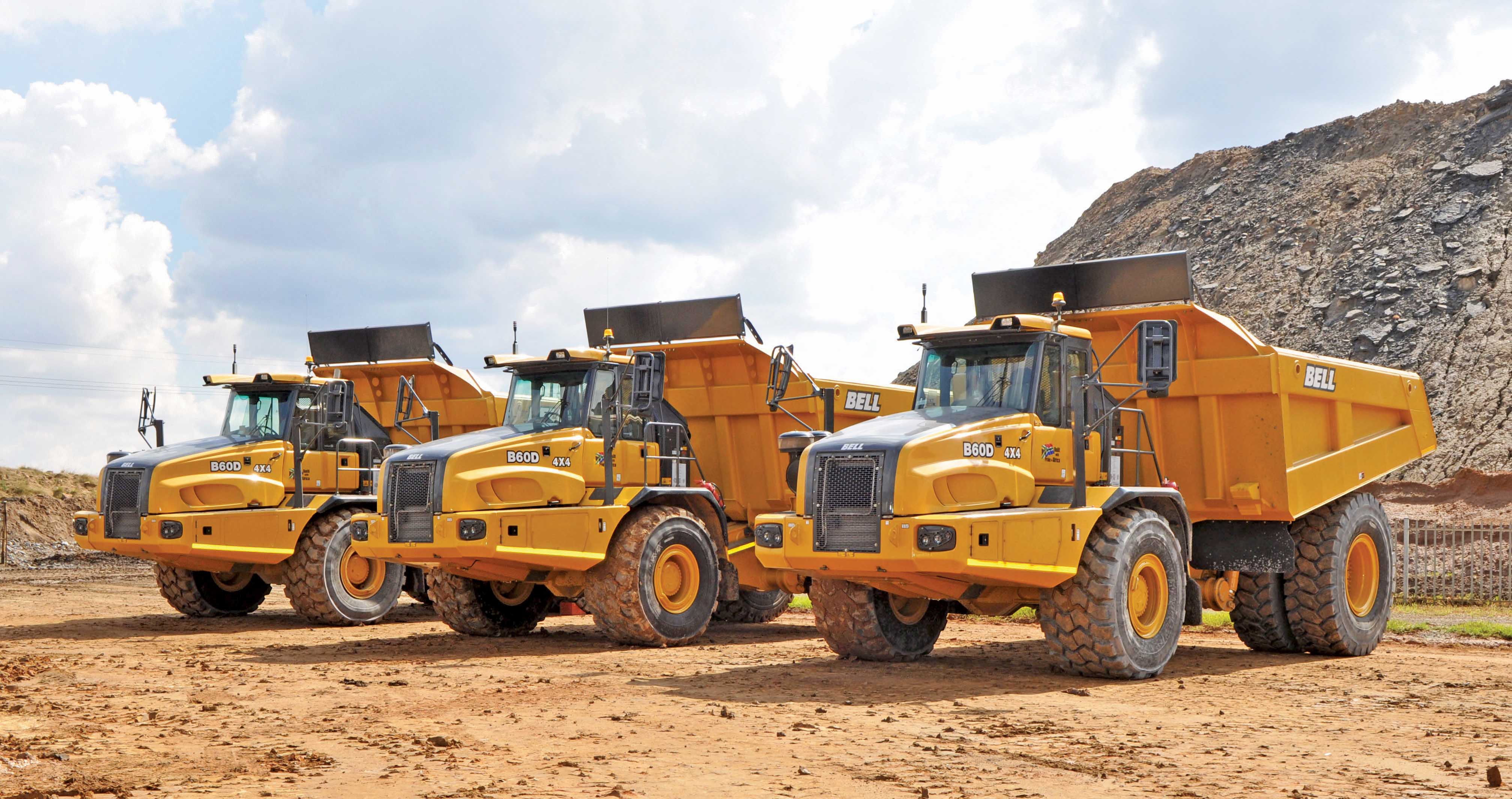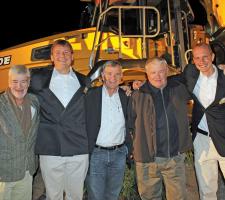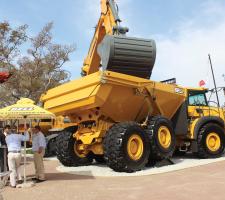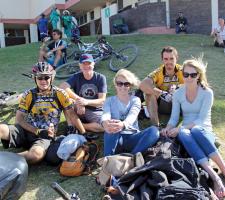
It was while enjoying a few beers with friends late at night three years ago that Gary Bell agreed to a rather daunting challenge.
“There’s a 300km mountain bike race in South Africa, the Sani2c, and somebody said ‘This is a good idea. I think we should all enter’. So we had to rush out and buy bikes and start training,” says Bell. “It’s one of the biggest mountain bike races in the world. I’ve done it three times now, and this year I took an hour-and-a-half off last year’s time.
“I’m 63 now and was 60 when I started mountain biking. I go riding most weekends and when it rains I’ve got an indoor bicycle. For business people, it’s apparently outdoing golf in its popularity.”
Gary is full of easy-going charm as he tells me about his admirable sporting achievements while he and I enjoy a special
It’s an exciting period for Bell Equipment, with a number of new ADTs set for release over the next year or so, encouraging sales growth in major truck markets, and with big ongoing investment in company plant assembly, logistics and customer service centres in both the Northern and Southern Hemispheres.
At
“The reception for it has been very good,” says Gary. “What’s even more exciting for us is that the E-series is more refined – meeting the new Tier 4/Stage IV emissions regulations and offering a few added features in the vehicles.
“We’ve got the very latest technology engines from Mercedes Benz. They are one of the global leaders in this area. It gives us a benefit on fuel economy and engine efficiency. With the E-series, we’re able to offer a very competitive global product. Going forward, this will enable us to grow some market share.”
Another big model for Bell is its new 60tonne truck – the B60E. “The E-series will be launched following the other large trucks, but we’ve sold about eight or nine D-series models and have a few more being tested by customers. We are getting some serious efficiency improvements,” stresses Gary.
Stephen Jones, Bell Group Executive - Marketing, Alliances and Dealers, elaborates: “Some of the test truck customers are saying that they are getting the running costs of a 40tonne truck on our 60tonne model.”
“It means one operator doing 50% more at the same running cost,” adds Gary. “For the mining guys, the B60E is interesting as it has the square loading target area of a rigid truck. We’re quite excited about this product. We’re targeting the bottom end of the rigid truck business. We’d like to see it at 100-120 truck sales a year.” Following the B50E, the B60E ADT is due to go into full production in late 2016 or early 2017.
Gary says his company is also developing “new concept” solutions in the 20-25tonne weight class. “We’ve seen over the years, particularly in the UK and other parts of Europe, quite a big portion of the small ADT business eroded by conventional on-highway trucks. There are 8x4s being used for roadworks traditionally done by an off-highway truck. So we’re working on a product that counters this: that’s very price competitive and also offers some off-highway capability.” The first new concept model is due to go on the market before the end of 2016.
Gary believes Bell Equipment’s trading philosophy helps the company standout in the highly competitive global ADT marketplace. “We’re not locked into having to use one company’s axles, gearboxes and engines. Our association with Mercedes Benz also means they are testing our trucks’ engines in the on-highway business five years before we get them.
“There’s huge step changes in technology. In the north of South Africa, we’re running tests against a competitor machine and we’re getting something like nearly 50% more fuel economy – nearly 50%! Everyone is talking about hybrid machines, but even today all engine manufacturers are talking about another 50% improvement in fuel economy over the next few years. Before you start making electric drives, hydrogen powered vehicles and all the rest of it, they say there’s an opportunity for far more efficient diesel engines. We, in the articulated truck business, can get the spin-off of that.”
Jones adds that due to Bell Equipment’s experienced team of engineers focusing on “nothing but trucks”, Bell ADTs are able to offer key operational efficiency advantages – the biggest being spin-offs from onboard weighing and truck positional technology. For example, with this, Bell ADTs know when they’re fully loaded and select the most fuel-efficient gear for their next onsite journey. The trucks also know when they’re going downhill empty or loaded and can compensate for this. Small tweaks like pulling off in second rather than first gear, when conditions allow, saves a gear shift and contributes to reduced running costs. Another example is ancillary systems like the cooling fans, which only kick in when the truck is going downhill, saving power and improving performance.
Turning his attention to key global markets, Gary is delighted by a big rise in US demand for articulated trucks – with the country representing 50% of the global sales market. The major market upturn has coincided with a large investment by Bell in its US dealerships after ending its ADT distribution agreement with
“At the end of 2012 we took the decision to go back into the market [solely as Bell Equipment]. Fortunately we did that as that’s the market that’s booming at the moment. We’ve done better than we expected. It’s kind of offset the downturn in the commodities market. Our coverage of the US is only 35-40% of what we’d like to see, so we’ve got plans to increase our footprint in that market.
“We’ve also this year set up a distributor in Central America, who looks after countries including Panama, Colombia, Costa Rica, Trinidad, Jamaica and other parts of the Caribbean. These are countries and a region where we’ve never previously had representation.”
Gary says the company is also looking to get more involved in the South American market, with a number of additional dealers set to be signed up, before adding: “As a company we need to do a bit more in terms of diversifying our activities globally, and there’s a few plans underway to do that. The mining and quarry downward cycle is deeper than we anticipated. Indeed it’s a bit worse now that we saw in 2008 and 2009. Fortunately, we’ve got a bit of a better spread across industries and world territories and we’re in relatively good shape going through 2015.
“We’re pushing ahead with getting the final larger E-Series ADTs to market. Outside USA, we’ve seen more sales volume from our 30tonne and down trucks and less of our 35tonne and over models, due to the state of the mining sector.”
A major event for Bell in 2016 will be the opening of the company’s new enlarged European logistics facility in Alsfeld, central Germany. The new facility will cover 12,000m², compared to the current 7,000m² facility on an adjacent site. The logistics hub is almost right in the centre of Germany, on the cusp of two north, south, east and west autobahn crosses, and an hour’s drive from Frankfurt and the city’s major international airport. The modern facility will have the latest technology and aim to deliver replacement ADT parts to European customers 24hours/day.
Bell Equipment’s final assembly facility for the Northern Hemisphere is also only one hour’s drive from Alsfeld in Eisenach – near the former Eastern German border.
Stressing the importance of the Germany-based facilities to the company’s long-term growth plans, Gary says: “Our European assembly plant in Germany will be sending out this year nearly 65% of all the trucks we sell worldwide. To ship large products like this around the world entails high costs. Our intention is to produce more of our product in Europe which will give us a significant cost reduction. With freight being our single biggest cost, this will ensure we remain globally competitive.”
Gary says that the relative weakness of the South African Rand against major market currencies such as the US dollar, the Euro, and British Sterling should benefit ADT sales to Northern Hemisphere customers.
Of Bell Equipment’s trading within the European ADT market, Gary says: “The UK market is doing really well. We had a record sales year last year and are having another good year this year. France is down. There are no big projects happening at this time. Germany is doing okay. Our biggest challenge is Russia. The market there is down more than 70%. I think what will help is the commodities cycle picking up. We’ve localised some manufacturing in Russia through a partnership with one of the country’s big truck manufacturers, who are building our truck bodies. It will give us a bit of a price advantage when the market improves.”
Bell Equipment’s long-standing South African production hub has been in the town of Richards Bay, 170km north of Durban in Kwa-Zulu-Natal. Focusing on the company’s home market, Gary continues: “It’s clear that the South African mining sector is under stress. We’re seeing some new business, but it’s generally truck replacements. There’s no major new mining projects underway.
“Everyone in the country has been waiting on the infrastructure spend on projects that are aligned to the Government’s National Development Plan. We’re now starting to see it due to private money investment and a lot of customers are a little bit more upbeat.
Gary emphasises how “no-one comes close” to Bell Equipment’s dealership coverage of sub-Saharan Africa. “We don’t only sell Bell products. We sell
Bell has made big investments in its sub-Saharan African customer service centres, including spending US$6-7 million in a state-of-the-art facility in Zambia. On this topic, Gary continues: “In the mining area here in South Africa, we’ve spent another $6-7 million on a customer service centre in Middelburg, which is essential for our coal mining customers.”
The company’s huge sub-Saharan Africa replacement parts distribution centre based next to O.R Tambo (Johannesburg) International Airport is said by Gary to ensure rapid delivery for the region’s customers. “If someone places an order, for example in Mozambique, in under 15 seconds the order is on a bar scanner and a guy is on his way to pick the part.”
Gary says Bell is also looking to grow its dealership reach in West Africa - with countries such as Nigeria rich in minerals and with need for quality mining and quarrying equipment.
Partly due to its history as a family-owned and run company, Gary is quick to emphasise the importance of Bell dealers’ knowledge of and relationship with every one of their customers. Using bauma Conexpo Africa 2015 as an example, he says: ““We’ve got a lot of our sales people from all over Africa at this show, but if a customer steps onto our stand he needs to be greeted by a Bell representative who knows him. You can go to some big company stands at major shows and you get a number and have to stand in line, maybe get a beer, but no-one recognises you.”
Some of the younger members of the Bell family are establishing themselves in the company. “One of my brother’s sons is on the main board; my youngest son is working in IT in our sales and distribution business; and then there’s two other lads who are in the design side of the business,” says Gary.
So what keeps driving the Bell Equipment Group’s CEO to achieve more hauling sector success? “We’ve got a sizeable market share on our products but it didn’t come easily. People say, ‘OK, it looks very nice, with a Mercedes Benz engine and all that’, then they would say, ‘Where’s this thing made?’ When you say ‘Africa’, it surprises them. It means it’s been a hard slog. Every deal we’ve had to go and prove that our haulers are better. Thankfully, I think we’ve now kind of got over that.
“The fact that most of our Northern Hemisphere machines are built in our plant in Germany also adds a bit of credibility, but the products we ship from here are shipped all over the world and are world-class. We love a shootout! That’s when we can show that our products are a little different, where we can deliver on better efficiency.”
With his passion for mountain biking keeping him in great health, Gary Bell can look forward to coordinating many more intriguing sales shootouts with other leading hauler OEMs. I and other industry scribes will be watching such battles with great interest.













